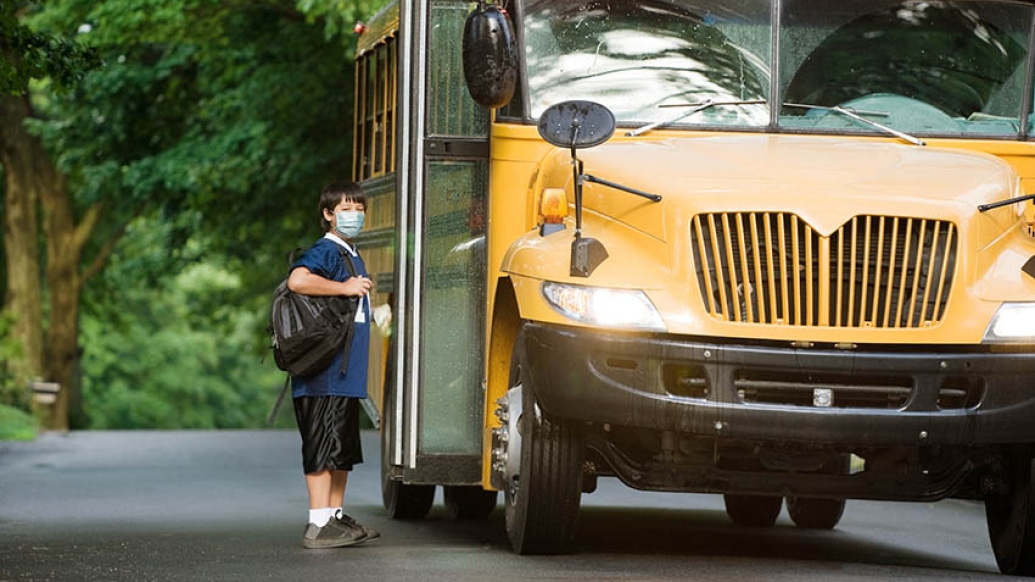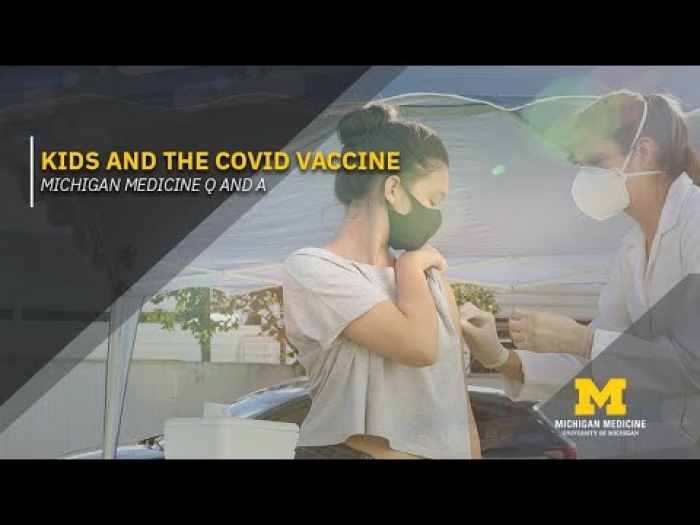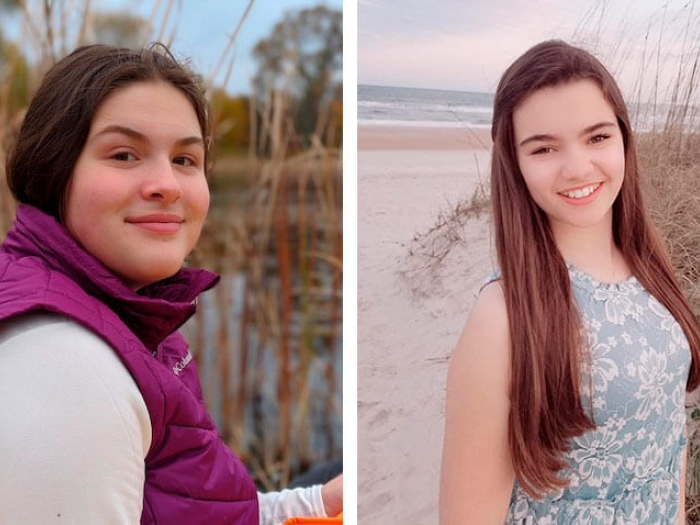As schools prepare for fall, a small study suggests that young children may carry coronavirus at high levels – but that doesn’t prove they’re contagious.
2:56 PM
Author |

Editor's note: Information on the COVID-19 crisis is constantly changing. For the latest numbers and updates, keep checking the CDC's website. For the most up-to-date information from Michigan Medicine, visit the hospital's Coronavirus (COVID-19) webpage.
As schools around the country consider reopening with in-person or virtual classes for fall, one important question remains unanswered: the role of children in spreading COVID-19.
Kids are not immune to the novel coronavirus, but a small number are getting infected and with milder symptoms. And while children are often known to be "superspreaders" of respiratory germs, they haven't seemed to be major transmitters of SARS-CoV-2.
But recent research raises new questions around these theories, with one study finding that infected children carry at least the same amount of coronavirus in their noses and throats as infected adults.
Experts caution that the study is small with limitations and doesn't mean that children are likely to pass the virus to others. Alison Tribble, M.D., a pediatric infectious diseases specialist at Michigan Medicine C.S. Mott Children's Hospital, answers some top questions.
What does the recent study about children and COVID-19 find?
Researchers evaluated RNA (the genetic blueprint of the virus) in nasal swabs taken from 145 infected people between March and April, including 46 children younger than five and 51 children aged 5 to 17. Children with serious symptoms requiring oxygen support – who would be most likely to have the highest detectable levels of the virus – were excluded.
The study, led by the Ann and Robert H. Lurie Children's Hospital of Chicago, found that children younger than five may host nearly 100 times the viral load of coronavirus in their upper respiratory tracts as adults. Meanwhile, those ages 5-17 had at least the same amount as infected adults.
The findings are consistent with an earlier study in Germany that included 47 infected children between ages 1 and 11.
Tribble says it's important to note that the tests looked for viral RNA, genetic pieces of the coronavirus, rather than the live virus itself. While this method helps provide an estimate of how much virus is present, it's not a completely reliable measurement.
Other limitations: The study was small and did not identify race, gender or whether participants had underlying conditions.
"We need to do more research to confirm these findings on a wider scale. But this does raise the possibility that even children who don't have many symptoms may carry and replicate the virus at high levels," Tribble says.
Does this mean kids can more easily spread COVID-19?
None of the available data so far is sufficient enough to conclude whether children may drive COVID-19 transmission, according to Tribble.
"Even if it holds true that children carry as much or more of the virus than adults, that does not automatically mean they are contagious or are likely to spread the disease," Tribble says.
"We don't fully understand the extent to which kids can fuel transmission, but studies like this indicate that it's certainly possible that they have a role. It reminds us of how much is still unknown about this virus."
Interested in a COVID-19 clinical trial? Health research is critical to ending the COVID-19 pandemic. Our researchers are hard at work to find vaccines and other ways to potentially prevent and treat the disease and need your help. Sign up to be considered for a clinical trial at Michigan Medicine.
Tribble notes that some preliminary research from other countries suggest there's less transmission between kids or kids to adults, especially among younger children. Small studies using contact tracers in Switzerland and Australia, for example, found that children were much less likely to be suspected spreaders of exposures in households or schools that had reopened.
And adults were more likely to infect children than the other way around.
"Kids may have high viral loads in their noses, but if that doesn't lead to transmission, it's not particularly concerning," Tribble says.
How does this research affect the conversation around reopening schools during the pandemic?
"We are continually seeing that we have much more to learn about this virus and why it's important to keep being cautious and vigilant in preventing the spread," Tribble says. "Schools that open must focus on mitigation measures, such as wearing masks and social distancing."
She notes that while children have so far been less affected by the virus, they have also presumably had less exposure because of school closures. A lack of testing early in the pandemic has also made it challenging to determine how many children were actually infected.
Even if it holds true that children carry as much or more of the virus than adults, that does not automatically mean they are contagious or are likely to spread the disease.Alison Tribble, M.D.
These factors make it difficult to predict how reopening schools may influence the transmission chain.
"We've never had all of our schools and daycares completely open during the pandemic, so we just don't know what that will look like," Tribble says. "Limited data suggests children are less likely to get COVID-19 and that they aren't superspreaders. But all of our information has been based on a time when schools were shut down.
"There's a lot of uncertainty about how this might shift when kids have higher community exposure from returning to school."
And school communities will have a vital role in influencing reopening risks, she says. The better they manage COVID-19, the less risk of transmission intensity in the school environment.
"The more spread there is throughout the community, the more likely that someone comes to school with the virus. Whether or not kids are efficient transmitters, there is increased risk of exposure," Tribble says.
"The community's COVID-19 transmission levels are really important. If they're too high, we won't be able to keep schools open."
Outside measures, such as closing bars and wearing masks, helps mitigate those risks for schools, she says.
Some have cited the recent outbreak at an overnight Georgia summer camp as a test case validating concerns about kids transmitting the virus. Nearly 600 Georgia residents attended the camp, and out of the 344 campers and staff whose test results were available, 260 tested positive.
But Tribble points out that Georgia's recent daily infection rate has also been particularly high, at almost 3,000- 4,000 cases a day. In comparison, Michigan, which is a similarly sized state, has recently seen an average of 600-700 new cases a day.
What is unclear, Tribble says, is whether just one person at the camp arrived with COVID-19 and all of the spread was within the camp – or if there were multiple seeding events, allowing it to spread more quickly. Participants were all tested prior to coming to camp but within 12 days of arrival, which means there were likely opportunities for people to get infected after being tested.
And those opportunities increase with higher community rates.
MORE FROM MICHIGAN: Sign up for our weekly newsletter
Other anomalies: The overnight camp involved people sleeping next to each other in cabins and having prolonged exposure. And while some mitigation efforts were implemented, such as enhanced cleaning of communal spaces and staff wearing masks, others were not. For example, children didn't reportedly wear masks, there were relatively large cohorts in each cabin and camp activities included "singing and cheering," which can enhance spread of the virus, according to the Centers for Disease Control and Prevention.
What are the biggest takeaways for parents surrounding children and COVID?
"When you hear this news that young children can carry 100 times the coronavirus levels in their noses as adults, that can sound alarming. But parents should keep in mind that this is just one step in better understanding how the virus behaves in kids," Tribble says.
"This information alone doesn't help us make any conclusions about the impact on children or their role in spreading the virus. We need to follow this with more robust studies."
As of July 21, 6.6% of reported COVID-19 cases and less than 0.1% of COVID-19-related deaths were among children and adolescents less than 18 years old, according to the CDC. A small number of children (up to about 600) have also experienced a potentially fatal, but usually treatable, COVID-19 related disease called multi-system inflammatory syndrome (MIS-C.)
Tribble says each family needs to make decisions about returning to school based on what's right for them. Multiple factors, such as having children or adults at home with underlying conditions and the transmission rate in individual communities, may guide choices.
"We know that school has a significant influence on a child's health and well-being with educational, social-behavioral and emotional benefits. But some families may need to weigh the risks of not providing in-person instruction against the health risks to their family," Tribble says.
The CDC has also created a decision-making tool to help parents weigh the risks and benefits of sending children back to school.
Tribble says parents should review their school's plan for implementing mitigation measures and make sure they are prepared for reducing the spread of coronavirus (e.g. wearing masks), maintaining clean and healthy environments, maintaining social distancing (e.g. staggering schedules and keeping students in small cohorts) and having a plan for when someone gets sick.
"No matter what we do, there will be some level of risk in opening schools," Tribble says. "We shouldn't view a positive COVID case at a school as a failure. We should be prepared for that scenario and be ready to stop the spread as soon as it happens."

Explore a variety of healthcare news & stories by visiting the Health Lab home page for more articles.

Department of Communication at Michigan Medicine
Want top health & research news weekly? Sign up for Health Lab’s newsletters today!





